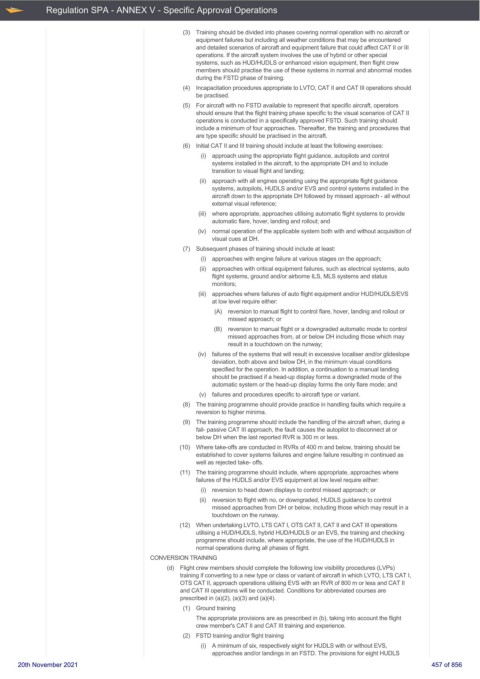Page 457 - UK Air Operations Regulations 201121
P. 457
~
~ Regulation SPA - ANNEX V - Specific Approval Operations Centrik
(3) Training should be divided into phases covering normal operation with no aircraft or
equipment failures but including all weather conditions that may be encountered
and detailed scenarios of aircraft and equipment failure that could affect CAT II or III
operations. If the aircraft system involves the use of hybrid or other special
systems, such as HUD/HUDLS or enhanced vision equipment, then flight crew
members should practise the use of these systems in normal and abnormal modes
during the FSTD phase of training.
(4) Incapacitation procedures appropriate to LVTO, CAT II and CAT III operations should
be practised.
(5) For aircraft with no FSTD available to represent that specific aircraft, operators
should ensure that the flight training phase specific to the visual scenarios of CAT II
operations is conducted in a specifically approved FSTD. Such training should
include a minimum of four approaches. Thereafter, the training and procedures that
are type specific should be practised in the aircraft.
(6) Initial CAT II and III training should include at least the following exercises:
(i) approach using the appropriate flight guidance, autopilots and control
systems installed in the aircraft, to the appropriate DH and to include
transition to visual flight and landing;
(ii) approach with all engines operating using the appropriate flight guidance
systems, autopilots, HUDLS and/or EVS and control systems installed in the
aircraft down to the appropriate DH followed by missed approach - all without
external visual reference;
(iii) where appropriate, approaches utilising automatic flight systems to provide
automatic flare, hover, landing and rollout; and
(iv) normal operation of the applicable system both with and without acquisition of
visual cues at DH.
(7) Subsequent phases of training should include at least:
(i) approaches with engine failure at various stages on the approach;
(ii) approaches with critical equipment failures, such as electrical systems, auto
flight systems, ground and/or airborne ILS, MLS systems and status
monitors;
(iii) approaches where failures of auto flight equipment and/or HUD/HUDLS/EVS
at low level require either:
(A) reversion to manual flight to control flare, hover, landing and rollout or
missed approach; or
(B) reversion to manual flight or a downgraded automatic mode to control
missed approaches from, at or below DH including those which may
result in a touchdown on the runway;
(iv) failures of the systems that will result in excessive localiser and/or glideslope
deviation, both above and below DH, in the minimum visual conditions
specified for the operation. In addition, a continuation to a manual landing
should be practised if a head-up display forms a downgraded mode of the
automatic system or the head-up display forms the only flare mode; and
(v) failures and procedures specific to aircraft type or variant.
(8) The training programme should provide practice in handling faults which require a
reversion to higher minima.
(9) The training programme should include the handling of the aircraft when, during a
fail- passive CAT III approach, the fault causes the autopilot to disconnect at or
below DH when the last reported RVR is 300 m or less.
(10) Where take-offs are conducted in RVRs of 400 m and below, training should be
established to cover systems failures and engine failure resulting in continued as
well as rejected take- offs.
(11) The training programme should include, where appropriate, approaches where
failures of the HUDLS and/or EVS equipment at low level require either:
(i) reversion to head down displays to control missed approach; or
(ii) reversion to flight with no, or downgraded, HUDLS guidance to control
missed approaches from DH or below, including those which may result in a
touchdown on the runway.
(12) When undertaking LVTO, LTS CAT I, OTS CAT II, CAT II and CAT III operations
utilising a HUD/HUDLS, hybrid HUD/HUDLS or an EVS, the training and checking
programme should include, where appropriate, the use of the HUD/HUDLS in
normal operations during all phases of flight.
CONVERSION TRAINING
(d) Flight crew members should complete the following low visibility procedures (LVPs)
training if converting to a new type or class or variant of aircraft in which LVTO, LTS CAT I,
OTS CAT II, approach operations utilising EVS with an RVR of 800 m or less and CAT II
and CAT III operations will be conducted. Conditions for abbreviated courses are
prescribed in (a)(2), (a)(3) and (a)(4).
(1) Ground training
The appropriate provisions are as prescribed in (b), taking into account the flight
crew member's CAT II and CAT III training and experience.
(2) FSTD training and/or flight training
(i) A minimum of six, respectively eight for HUDLS with or without EVS,
approaches and/or landings in an FSTD. The provisions for eight HUDLS
20th November 2021 457 of 856

